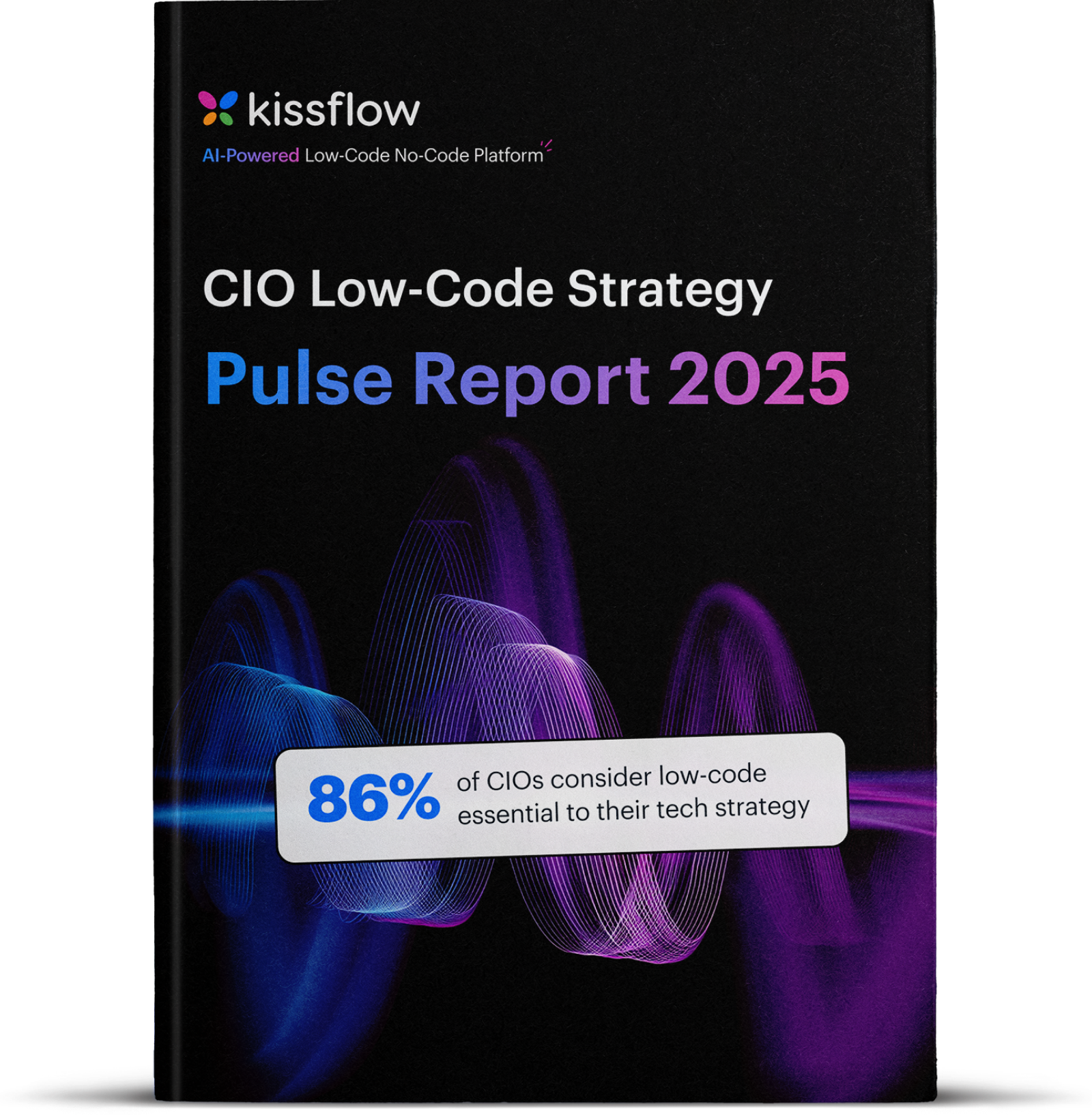
Modernizing legacy systems isn’t just an IT task; it’s a strategic necessity for enterprise growth. Legacy applications slow teams down, create bottlenecks, and fail to meet the expectations of digital-first businesses. Application modernization tools help organizations refactor, replatform, or replace outdated systems with more scalable, efficient, and user-centric platforms.
In this page, you’ll find a curated list of application modernization tools designed to meet enterprise needs, categorized based on ease of use, integration capabilities, modernization strategy, and suitability for internal IT teams or business users.
What is application modernization?
Application modernization the process of updating and transforming legacy software systems to leverage modern cloud-native technologies, improving performance, scalability, and security while meeting evolving business demands. This transformation typically involves migrating applications from on-premises infrastructure to cloud platforms for enhanced agility and operational efficiency
Image Source: All product screenshots on this page are sourced from Capterra India.
| Feature / Attribute |
|
|
|
|
|
|---|---|---|---|---|---|
|
Best for
|
Internal app modernization, departmental tools |
Full-stack enterprise modernization |
Microsoft ecosystem enhancements |
Modular modernization with AI assistance |
IT-centric workflow modernization |
|
Ease of Use
|
★★★★★ |
★★☆☆☆ |
★★★☆☆ |
★★★☆☆ |
★★★☆☆ |
|
Governance & Security
|
Strong built-in controls |
Enterprise |
Solid within Microsoft stack |
Role-based access, audit logs |
Strong for IT workflows |
|
Integration Strength
|
Native integrations + API |
Extensive with legacy support |
Seamless with Microsoft tools |
Cloud and on-prem friendly |
Native to ServiceNow suite |
|
Pricing Transparency
|
Transparent pricing |
Custom quote only |
Mixed (some tiers public) |
Custom quote only |
Enterprise plans only |
Kissflow
Kissflow is a no-code and low-code platform purpose-built to handle internal application backlogs. Designed for enterprises seeking agility, it supports modernization without rearchitecting everything from scratch. Whether you're looking to rebuild legacy apps as modular digital workflows or build department-level tools without writing code, Kissflow offers a unified solution with strong governance.
Strength: High speed of development, minimal learning curve, and tight IT oversight
Not ideal for: Tier-1 enterprise-grade systems like core banking or ERPs
Best for: Internal process modernization, department apps, and citizen development
-
Visual development for every user
Kissflow offers a drag-and-drop app builder accessible to both IT developers and business process owners, enabling faster modernization of legacy workflows without heavy coding.
-
Built-in governance and controls
The platform includes access controls, versioning, and audit trails, making it easy to enforce compliance and manage change at scale.
-
Unified platform for apps and workflows
Kissflow combines workflow automation, app development, reporting, and collaboration into a single platform to avoid fragmentation.
-
Prebuilt connectors and API support
Easily integrate with existing ERP, HRMS, and legacy systems through ready connectors and a flexible API framework.
-
Low learning curve
Non-technical users can modernize applications quickly without needing full-stack development experience.
-
Clears internal app backlog
Ideal for CIOs aiming to reduce IT backlogs by letting departments take ownership of modernization within a governed environment.
I like that the Kissflow platform is completely versatile, since its functionality can be customized and adapted to the requirements of each of our departments separately. It is accompanied by an intuitive interface with a relatively short learning curve, which provides the opportunity to not have extensive prior preparation to be able to implement its tools.
Nikki H
Account Supervisor, Marketing and Advertising
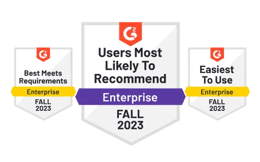
Experience the power of Kissflow firsthand
Microsoft PowerApps
OutSystems is a powerful low-code platform suited for large-scale modernization projects. It supports legacy migrations with its advanced integration tools and allows developers to build and deploy enterprise-grade apps with full-stack customization.
Best for: Core system replacement, multi-tier architecture, pro-developer teams
Strength: Deep integration options, scalability
Not ideal for: Business users or non-technical process owners
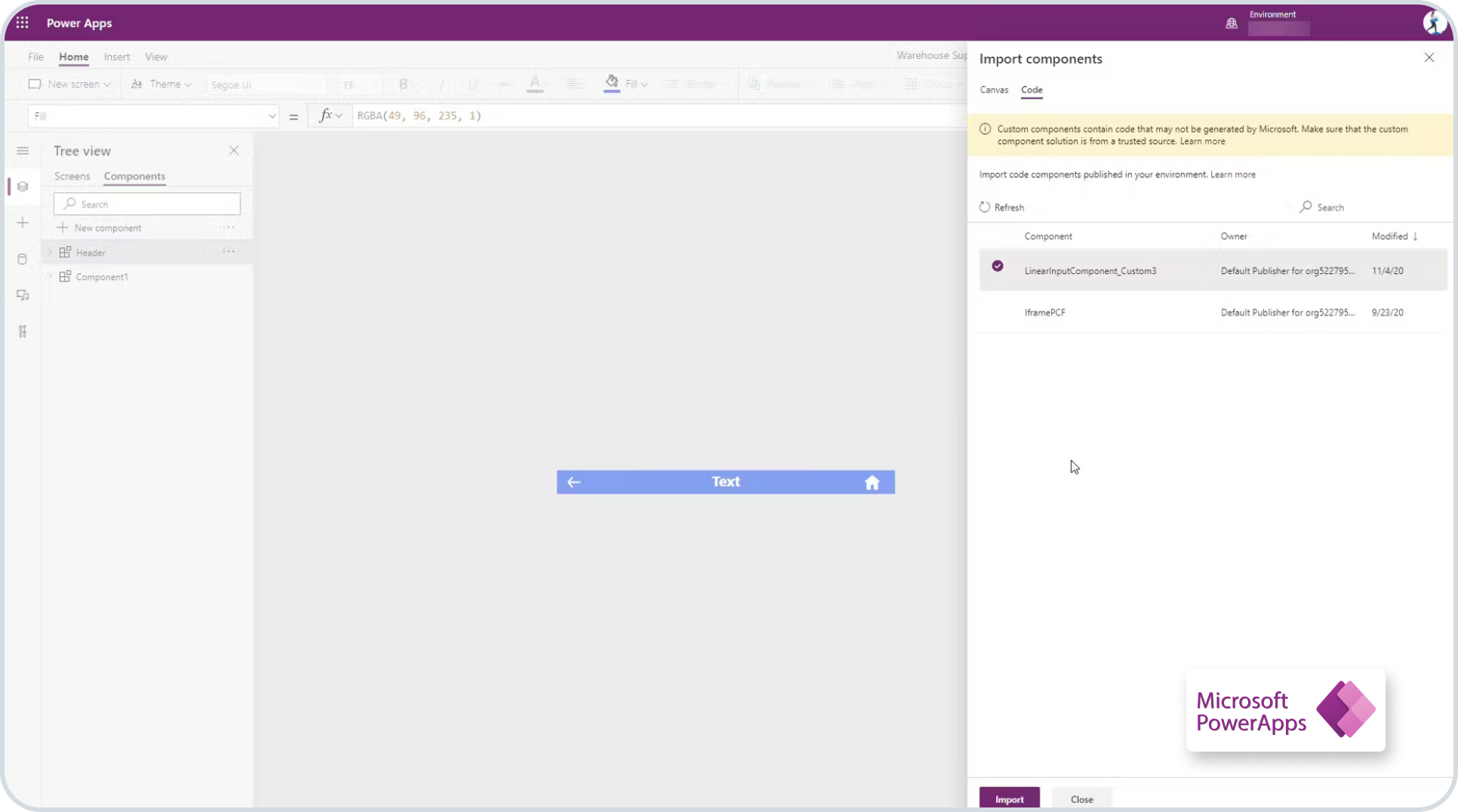
-
Seamless Microsoft ecosystem integration
Built to work naturally with Microsoft 365, Dynamics, and Azure, Power Platform allows for modernization without leaving the Microsoft environment.
-
Modular tools for automation and data
Power Apps, Power Automate, Power BI, and Dataverse allow teams to build, automate, and analyze modern apps using shared data services.
-
Ideal for Microsoft-centric organizations
Familiarity with the ecosystem reduces the need for extensive training and allows for quicker adoption.
-
Flexible use across departments
Power Platform supports a mix of IT-led and business-led development within the same environment.

"Microsoft Power Apps is lauded for its user-friendly approach to creating custom business applications. With a drag-and-drop interface, seamless data integration, and connections to other Microsoft tools, I can quickly develop powerful apps for my company. Its visual development approach, integration with other Microsoft tools like Power BI and Power Automate, and cross-device compatibility make it a great product."
Vikram J.
Sr. Data Analyst
-
Vendor lock-in
The platform is tightly integrated with Microsoft services, making it harder to adapt in non-Microsoft ecosystems.
-
Complexity with scale
Managing large deployments across multiple apps and users can become difficult without robust governance planning.

"If we have more complex functionality with more logic embedded into the app, debugging can often be difficult. We have to use little hacks to debug the app which is time consuming. Another problem is that it is hard to work with the delegation errors. Making a simple filter using the "in" operator cuases problems sometimes, when this should be simple. Also, the data limitations of 2000 records makes it hard to work with this app. Often, our lists go up to 5000 records and we need to be able to pull in those records into the app in a gallery. Otherwise it results in loading issues."
Jasmine M.
Developer/Analyst
Appian
Mendix combines high-productivity development with AI assistance for legacy modernization. It supports a range of deployment environments, including on-premise and multi-cloud.
Best for: Large teams with mixed technical skill levels
Strength: Enterprise architecture alignment, support for DevOps
Not ideal for: Quick-turnaround internal apps with narrow use cases
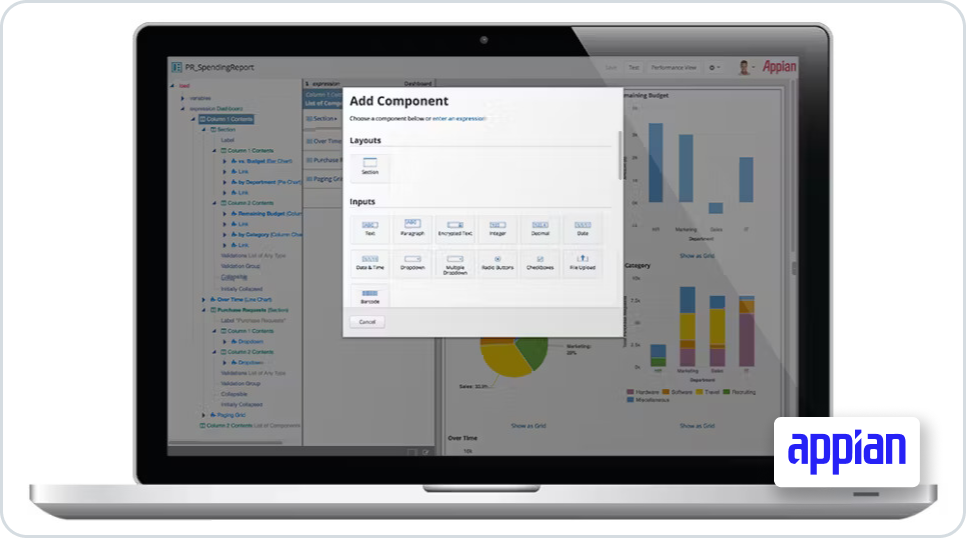
-
Process discovery
Achieve end-to-end process optimization by combining data from across the organization and generating detailed insights.
-
Data fabric
A no-code data management tool and virtualized layer that allows you to get a unified view by connecting data across disparate systems.
-
Increased developer productivity
With reusable components, drag-and-drop features, and the ability to access data anywhere, developers can speed up deployment.
-
Appian Community
Appian has a free community version for users to explore the platform and offers free courses that will help users get started on it.

"Appian is a low-code automation platform that helps organizations build applications and automate business processes quickly. The platform aims to solve various problems related to application development and business process management."
Arulanandham K.
Practice Head of Digital Integration / Hyperautomation Expert
-
Steep learning curve
The platform requires a lot of training and deep knowledge before users can begin building applications on it.
-
Unpredictable development time
Development can take anywhere from 8 weeks to 8 months, depending on the complexity and number of applications to be built.

"The product doesn't gel well with JMeter performance testing tool. Malformed Chunk Coding Exception is frequently encountered. After the recent upgrade, the Appian designer UI is difficult to navigate."
Parthasarathy K.
Performance Test Consultant
Mendix
Mendix combines high-productivity development with AI assistance for legacy modernization. It supports a range of deployment environments, including on-premise and multi-cloud.
Best for: Large teams with mixed technical skill levels
Strength: Enterprise architecture alignment, support for DevOps
Not ideal for: Quick-turnaround internal apps with narrow use cases
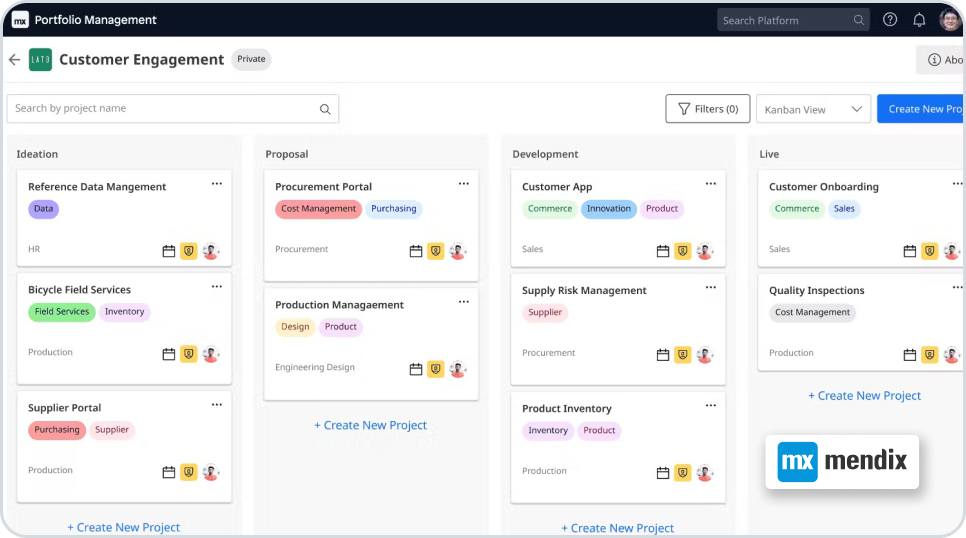
-
Mobile app development
Mendix empowers cross-platform development for all users, regardless of their device or operating system.
-
Offline apps
The platform enables the building of fully functional offline apps for native and hybrid apps.
-
Native app development
Build apps in a fast and responsive environment and get the best long-term value from native app development.
-
Accessibility
Uninterrupted offline access to apps makes the platform more flexible even when users lose connectivity.

"A faster way to develop your website without less hassle. I like how quickly on can start developing in the Mendix application even with very little knowledge of coding. The rapid course also gives you a great boost."
Subhojit P.
Associate IT Consultant
-
Difficult for business users
Although the platform claims it’s friendly for business users, it is too complex for them to use.
-
Limited to Windows
You can only adopt this platform if your enterprise operates exclusively within a Windows environment.
-
Deployment
One-click deployment is unavailable on this platform, so deployments must be managed manually.

"While developing a simple application is really easy using Mendix, when the logic is more complex and the operations are more sophisticated, the process gets harder. Because of development speed every change in requirements is twice as painful. The platform is also not the best when it comes to performance - some operations are impossible to be developed optimally without usage of java code. Also mendix academy courses have errors which makes it hard to train newcomers in the technology."
Kacper K.
Software Developer
ServiceNow
Built on the ServiceNow platform, App Engine helps IT teams modernize operations-focused workflows. It’s best used where there’s already heavy reliance on the ServiceNow ecosystem.
Best for: IT operations, service workflows
Strength: Strong native process automation capabilities
Not ideal for: Non-IT use cases or broad departmental apps
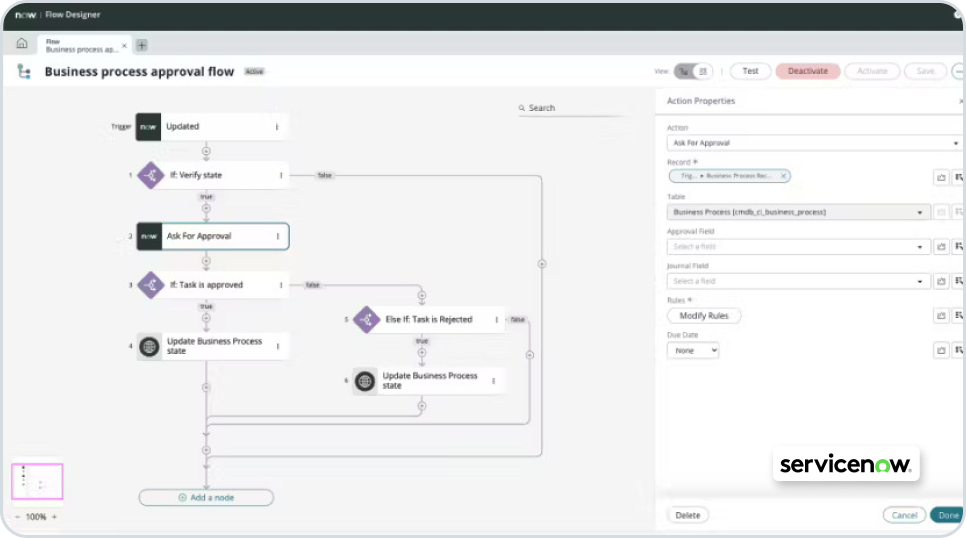
-
ITOM
Group key applications and capabilities into packages and scale as your business grows and changes.
-
Low-code app development
Use the App Engine to build custom apps on one platform and reduce time-to-market by half.
-
Advanced IT service management
Cover a wide range of scenarios with the platform’s out-of-box and advanced ITSM capabilities.
-
Dedicated solutions
The platform offers specific solutions like App Engine, SecOps and CSM for customer, employee and developer workflows.
-
Scalability
The platform’s architecture ensures Advanced High Availability, which surpasses strict requirements for data sovereignty, availability, and performance.
-
Extensive training
Users find it hard to understand the complexities of the platform and apply best practices without extensive training.
-
Not for business users
Only developers can build apps on the platform, slowing development time.
-
Limited low-code
ServiceNow was primarily built as an ITSM platform, so their low-code offerings are limited.
Why use application modernization tools?
- Reduce technical debt: Minimize the cost of maintaining outdated systems and redirect IT capacity toward innovation.
- Improve flexibility and speed: Enable faster iterations and feature additions with visual development and modular architecture.
- Enhance user experience: Provide responsive, mobile-ready interfaces aligned with modern UX standards.
- Support hybrid teams: Allow both IT and business users to participate in app development through visual tools and governed environments.
Choosing the right tool
When choosing a modernization platform, consider the following:
- Integration needs: Does it connect with your current systems (ERP, CRM, legacy databases)?
- Target users: Will apps be built by IT teams, business users, or both?
- Use case priority: Are you replacing core systems or digitizing departmental workflows?
- Governance: Does the platform support role-based access, audit trails, and versioning?
Kissflow, for instance, supports business-led automation with IT oversight, making it ideal for organizations looking to offload internal app backlogs while retaining control.
Application modernization is a strategic move: Relying on outdated systems limits growth, introduces risk, and hinders collaboration. Whether you’re modernizing to move to the cloud, meet compliance requirements, or simplify operations, the right tool can accelerate results without introducing complexity.
Kissflow makes it simple for IT teams and process owners to work together on modernizing legacy systems. No complex architecture. No long implementation cycles.
Join thousands of enterprises already modernizing with low-code

Kissflow's Low-Code ROI Report
Thank you for downloading the ebook!
Related Articles








